Problems of Industrial Electrification (forced decarbonization on the firing line)
By Mark Krebs and Tom Tanton -- January 9, 2020“With 25.3 Quads ‘lost’ in the transition from ‘source’ to ‘site’ (a.k.a. metered) electricity consumption, the overall electrical generation efficiency in industrial processes is 34% (13 Quads ÷ 38.3 Quads). In comparison, direct use of fossil fuel on site at industrial facilities generally exceeds 90%.”
“Industrial electrification is largely being driven by the same cabal pushing deep decarbonization and is further undermining our market economy. The solution: Remove subsidies, mandates and other forms of energy favoritism by letting technologies advance or fail in markets based upon their own true merit or lack thereof.”
Previous articles at Master Resource have focused on “deep decarbonization” through allegedly beneficial electrification of residential and commercial buildings. We’ve discussed the negative consequences of various policy regimes to deny consumers choice to best satisfy their energy usage requirements.
Other posts have focused on electric vehicles (EV’s) as part of a grand public effort to back-out motor fuel in favor of what is hoped to be renewable-based electricity. (As it is now, EV’s are ‘emission elsewhere’ vehicles.)
What about industrial electrification, a large potential target for the deep-decarbonization movement.
Since about 1984, advocates of electrification have had a loud voice on the topic of industrial electrification. But what is the rest of the story? Why does the self-interest of plant owners reject a politically correct substitution? The purpose of this article is to address some of the consequences (unintended or otherwise) thereof of industrial electrification.
Electricity by End Use Sector
The following diagram outlines the basic roadmap for the envisioned electric load growth via “beneficial” electrification in terms of Quadrillion Btu’s (Quads or 1015 Btu):
Electricity by End Use Sector
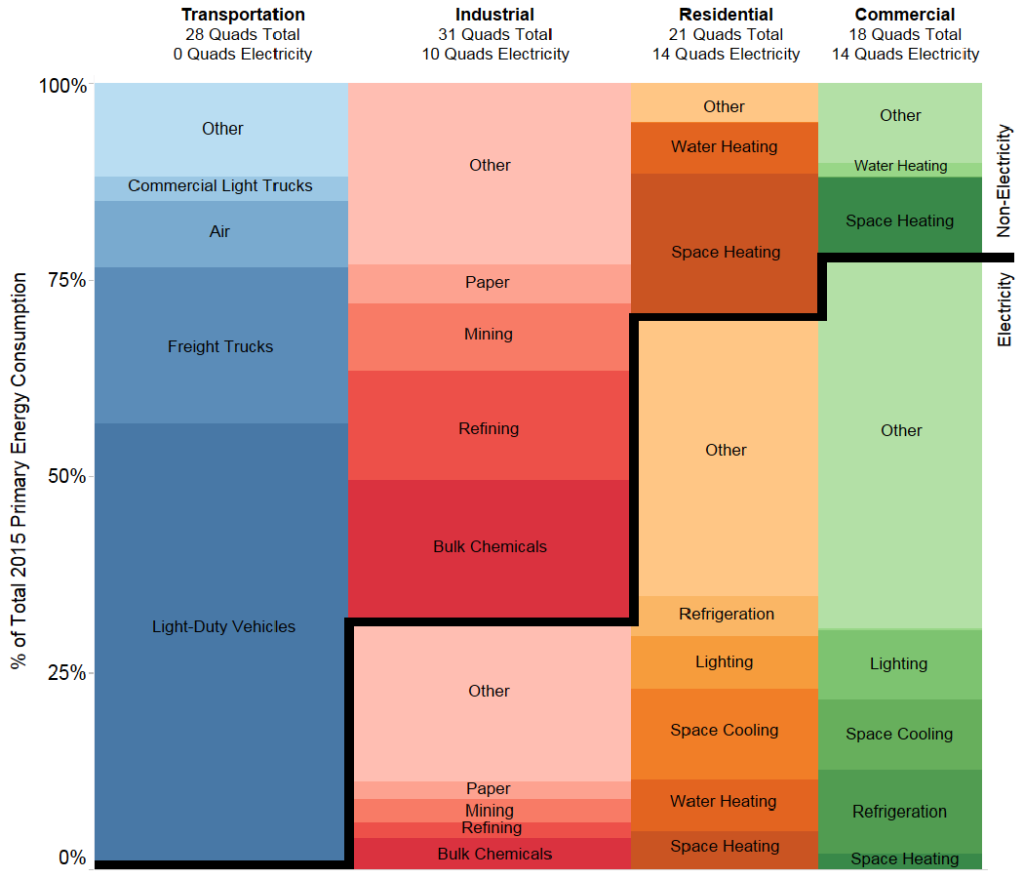
Source: National Renewable Energy Laboratory. NREL/TP-6A20-70485
The area above the solid black steps represents the theoretical yet technical potential for converting from the direct use of fossil fuels to electricity for each of the sectors portrayed. The above diagram can be further simplified to show market share potential per sector for increasing electricity consumption as follows:
- Transportation: 28 quads minus 0 = 28 Quads
- Industrial: 31 Quads minus 10 = 21 Quads
- Residential: 21 Quads minus 14 = 7 Quads
- Commercial: 18 Quads minus 14 = 4 Quads
Total = 60 Quads
As shown above, total electrification potential for these four economic sectors equals 60 Quads. For reference, the U.S. Energy Information Agency (EIA) states that 13 Quads of electricity were sold at retail in 2018; requiring the consumption of 38.3 Quads of primary (a.k.a. “source”) energy consumption of various forms per the following graphic:
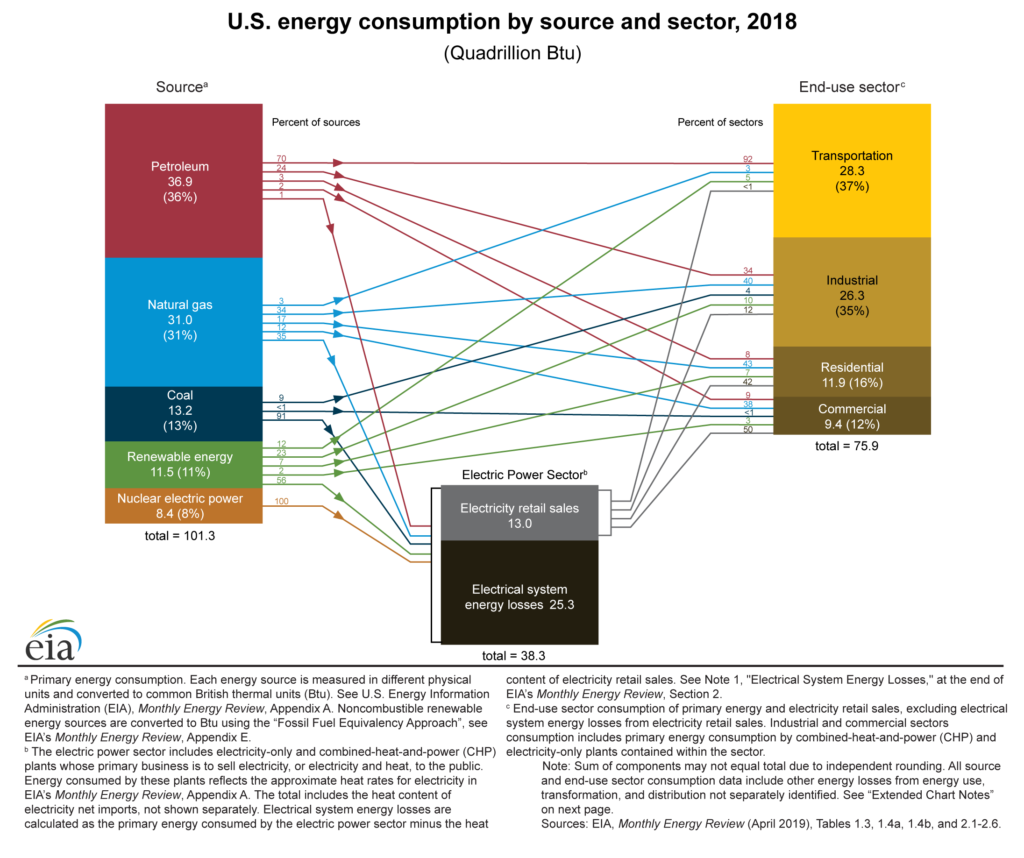
With 25.3 Quads “lost” in the transition from “source” to “site” (a.k.a. metered) electricity consumption, the overall electrical generation efficiency for industrial processes is 34% (13 Quads ÷ 38.3 Quads). In comparison, direct use of fossil fuel on site at industrial facilities generally exceeds 90%.
In other words, for every Quad of electricity delivered to consumers, there are nearly two (2) Quads of waste (1.95 Quads to be more exact). Thus, increasing the use of electricity by 60 Quads would entail an additional 117 Quads of waste (at 2018 overall electricity efficiencies according to EIA’s most recent data), not to mention the huge misallocation of capital to build additional (redundant) generation and transmission infrastructure. This misallocation may exceed $30 Trillion.
According to the National Academies of Science (NAS), natural gas provides the largest portion of U.S. industrial energy use overall (at 30% and growing in 2015). However, different industries have vastly different energy intensities and requirements; thus, vastly different proportions of total production costs represented by energy.
It is also important to recognize that different industries have different requirements for the quality of energy they require. Industries reliant on digital controls, such as computer chip manufacturers, require ‘perfect power’ in the form of “nine-nines” reliability, but also zero harmonic distortion and voltage/frequency variation. That requires electricity.
Generally, industries more reliant on providing heat are served quite well at less cost by the direct use of fuel.
However, “nine nines” quality electricity can also be produced on-site through natural gas-fueled combined heat & power (CHP); with the added benefit that any thermal requirements may be simultaneously offset through “waste” heat recovery.
Natural Gas Beats Renewables
In comparison with advanced gas technologies, the purported environmental and economic benefits of full scale electrification begin to look highly doubtful. Avoiding such doubts is usually abetted by beliefs that renewables will soon become the least expensive means of producing electricity; if they aren’t already; as argued by the International Renewable Energy Agency, Lazard and their darling technology advocates (e.g., “The Numbers are In and Renewables are Winning On Price Alone.”
Such beliefs are further predicated on the following fallacies:
- A belief that fossil fuels will forever increase in price.
- The value proposition of fossil energy versus renewable energy is the same.
- A willful ignorance of ongoing advances of non-electric energy alternatives.
The first two fallacies are evidenced by historical data and the intermittent nature of renewables. Further, while renewable equipment costs have been declining, fossil-fuel equipment and the commodity itself are also becoming more economic. Oil and gas costs, moreover, can be locked-in for months, years, or longer to remove price risk.
More importantly, renewable costs have not lowered overall retail electricity prices for any sector. Per EIA data, the opposite is true: electricity prices are increasing.
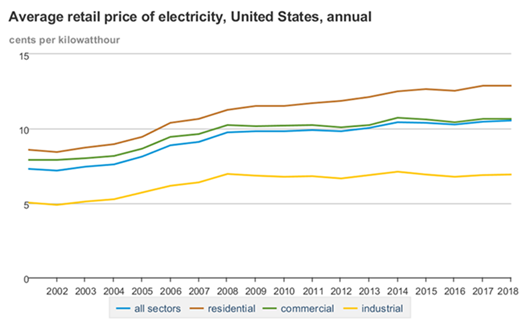
The following excerpt is from the above NAS reference:
Industrial energy needs are projected to grow by 31% during the next 25 years, when they will account for about 38% of total U.S. consumption. Part of this increase may occur because some manufacturing activities formerly located overseas are returning to the United States, in response to a recent trend toward lower natural gas prices prompted by increases in domestic production.
Leave the Market Alone
As predicted, such growth has returned to the U.S. and with it, record employment. The remaining discussion explains how government-imposed industrial electrification puts such growth at risk.
As the previous graphic illustrated, while average retail prices of electricity for industrial consumers is increasing, natural gas prices (tariffs) for industrial consumers is decreasing according to EIA data.
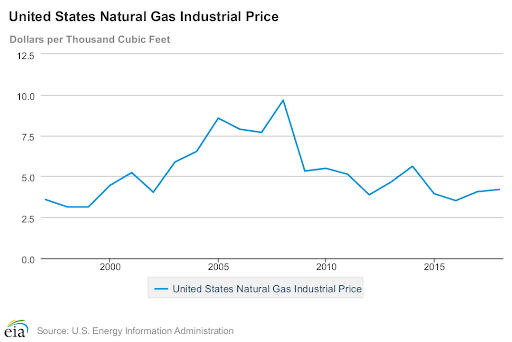
Like other consumer groups, industrial consumers usually opt for the most affordable energy choices (assuming they have a choice). Furthermore, industrial energy consumers are, at least arguably, the most economically literate about their energy choices.
However, energy prices are not the only costs that the industrial sector contends with. Labor costs and regulations (particularly environmental regulations) also affect profitability. Such concerns can and do cause industry to shut down or move elsewhere. Just look at the flight from California as evidence. Business flight (a.k.a. economic leakage) has real environmental impacts (a.k.a. emissions leakage) as further described below.
Increasing energy costs adds pressure that can lead to decreased overall employment and higher trade deficits. On top of this comes increased automation trends of the workplace. The main point here is that even just maintaining current favorable employment numbers is likely to become harder; there is nothing to be gained by unnecessarily adding cost burdens to industry and energy costs is one such burden.
Given these factors, there is at least a likelihood that present record employment may be short-lived because of a perfect storm of avoidable policy missteps, including:
- Rejoining the Paris Accord
- Implementing Carbon taxes and/or pricing (e.g., cap & trade)
- Refusing to let expire clean energy mandates (e.g., renewable energy portfolio standards)
- Allowing utilities to virtue signal at no cost by approving recovery of such costs through energy rates
To varying extents, these policies are in place in Europe but not yet widespread in USA. Thus, expanding such policies at home will only accelerate shifting industrial output to “elsewhere” like Asia, Africa and South America. Consequently, the probability exists for:
- Increased carbon emissions’ leakage due to moving manufacturing to countries with less stringent environmental regulation, as we’ve seen in California.
- Increased carbon emissions from transporting manufactured products over longer distances from maker to user.
- Reduced economic resources available to address more pressing social problems as articulated by Bjorn Lomborg fifteen years ago.
Further exporting industrial emissions out of the U.S. (and thus increasing total emissions) makes no sense environmentally or economically; yet that is likely to happen as a direct result of limiting consumer choice through ostensibly “beneficial” electrification. Instead, healthy competition is much better fostered through knowledgeable consumers free to select whatever energy alternatives best fit their specific requirements.
Conclusion
On December 12, 2019, the U.S. Department of Energy’s “Better Buildings” programs sponsored a webinar titled “Electrification – What Does It Mean for Energy Efficiency?” Basically, what it means is that utility energy efficiency programs may be increasingly ‘redirected’ to programs to minimize carbon at the point of energy end use. A case-in-point is summarized by the following slide; presented by the Sacramento Municipal Utility District:
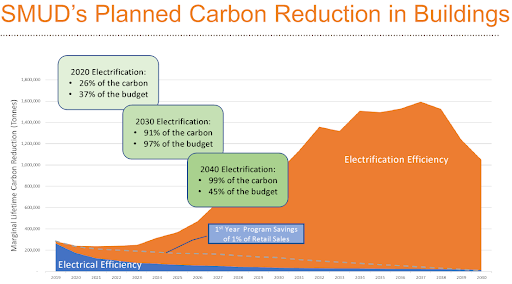
While the title of the slide clearly states that it applies to buildings, industry uses buildings too and similar programs most likely will include a carbon takeover of industrial processes and transport. But don’t bother trying to find the presentation this slide came from: The presentation was only sent to registered attendees; so it is being made available here.
Appendix
Additional references advocating for industrial electrification:
- Forbes: How To Reach U.S. Net Zero Emissions By 2050: Decarbonizing Industry
- APPA (American Public Power Association): New loads, new challenges: Advancing industrial electrification
- NREL (National Renewable Energy Lab): Electrification of Industry
- LBNL (Lawrence Berkeley National Lab): Electrification of buildings and industry in the United States
The latter two references are federally (taxpayer) funded national labs actively supporting (advocating) the electrification of all energy uses in the U.S. The first two references are merely commercial interests exploiting federal “research” to advance electricity growth.
Meanwhile, industrial technologies that use natural gas directly are not dependent upon federal “energy efficiency” largesse but are also improving none-the-less. Examples are identified within the following links:
Industrial electrification is largely being driven by the same cabal pushing deep decarbonization and is further undermining our market economy. The solution: Remove subsidies, mandates and other forms of energy favoritism by letting technologies advance or fail in markets based upon their own true merit or lack thereof.
—————————
Mark Krebs, an engineer by training, has been involved with energy efficiency design and program evaluation for more than thirty years. He has served as an expert witness in dozens of energy-efficiency filings, which he first summarized in a Public Utilities Fortnightly article, “It’s a War Out There: A Gas Man Questions Electric Efficiency” (December 1996).
Tom Tanton (ttanton@fastkat.com) is Director with Energy and Environmental Legal Institute. Mr. Tanton has 40 years in energy and environmental policy, focused on enabling technology choice and economic development. Mr. Tanton has testified to numerous state Legislatures and Congress as an expert on energy policy. He formerly served as Principal Policy Advisor at the California Energy Commission.
UPDATE:
Yesterday, the House Energy & Commerce committee released a framework document for its upcoming “Climate Leadership and Environmental Action for our Nation’s (CLEAN) Future” Act.
https://energycommerce.house.gov/sites/democrats.energycommerce.house.gov/files/documents/CLEAN%20Future%20Act%20Memo%2001.08.20.pdf
It basically outlines a path for economy-wide “deep decarbonization” via electrification.
Among other things, it stipulates that clean energy is electric energy with an annual carbon intensity lower than 0.82 metric tons/Mega-Watt hour.
This make ordinary coal plants qualify as clean with a slight amount of carbon capture:
https://www.igu.org/sites/default/files/node-page-field_file/FactsFigures_8.pdf.
Title V covers industrial decarbonization electrification.
Thanks for the SMUD plan. I’ll try to get it to download tonight. By chance did SMUD discuss using Vehicle to Home technology. We are planning on our using our 26 gallon vehicle fuel tank to supply our Honda generator when we have to deal with PSPS’s in the future.
We don’t plan on electrifying our hot water tanks as our TOU rate plan means we pay 30 cents or more from PG&E for our marginal use in the winter. We paid under a 10 cents in the winter for our baseline use as few years back.
FYI- https://energyathaas.wordpress.com/2020/01/06/fossil-fuels-are-dead-long-live-fossil-fuels/comment-page-2/#comments
Can the authors comment on this statement from Vaclav Smil (Power Density, p. 25):
“… the only two important commercial applications in which electricity cannot compete with fuel are … the production of iron from its ores (where coke or charcoal remains indispensable) and commercial flying, where kerosene remains the only practical choice for jetliners.”
[…] https://www.masterresource.org/deep-decarbonization-electricity-for-gas-mandates/problems-of-industr… […]
[…] Problems of Industrial Electrification (forced decarbonization on the firing line) […]
What Smil is referring to in the first case is steel making from iron ore in a blast furnace. All steel needs carbon. We should start with a working definition of steel: Iron alloyed with carbon (around 1%).
Blast furnaces produce steel from iron ore where the fuel is “coke” (a form of processed coal). The electric alternative to a blast furnace is the arc furnace. Arc furnaces produce steel from (recycled) scrap (predominately).
In blast furnaces using iron ore, the coke supplies the carbon. Arc furnaces get their carbon from the scrap and/or must add some carbon to achieve whatever steel recipe they are trying to make.
What process you choose, blast or arc, largely depends mainly on what your raw material is (ore or scrap) and what fuel costs are. Another determining factor is size: Blast furnaces can be gigantic whereas, arc furnaces tend to be small/modular.
My answer is that it depends; but blast furnaces usually win-out based on operational economics in terms of competing energy costs. As for aviation, it’s all about on-board fuel density and economics. Yeah, electric airplanes exist and are being used commercially for VERY short hops:
https://www.geekwire.com/2019/harbour-airs-electric-seaplane-makes-first-flight-sparking-quiet-buzz-b-c/
But I don’t see electric airplanes dominating any time soon.
[…] Problems of Industrial Electrification (forced decarbonization on the firing line) […]
It seems that SolarEdge is working on VTH/office? technologies(1)
Given that the CAL grid has a lot of curtailed solar during the day I would of thought the state would be encouraging changing at work and not so much at home as the efficiencies are going to be shot to heck if you have to store the over generation in stationary batteries to later dump the juice back to the grid for within day use day (24 hour cycle) to charge up your EV at home.
A shinny new 12 stall Tesla charging station was installed a few miles down the hill from me recently. The station appears to be on the same distribution line that was powered by 3 truck sized diesel generators during the recent PSPS’s. A 4th generator was brought into the substation for the 5th planned PSPS last fall. Luckily the event was called off as the wind event never materialized. Unfortunately the entire school system was shut down as the event wasn’t called off in time to get all the OES plans turned around.
1) https://cinnamon.energy/solaredge-perspective-for-a-distributed-grid/
I have a pet peeve: I abhor the use of acronyms without the provision of a definition. For anyone involved in persuasive writing, it is an egregious offense.
What is PSPS?
What is SMUD?
What is OES?
I’ve already wasted five minutes trying to find definitions. I’m not going to waste any more time.
Can’t blame you John.
SMUD = Sacramento Municipal Utility District
PSPS = “Public Safety Power Shutoff” (a Californic term)
OES = https://www.caloes.ca.gov/ (” )
PS: I spelled out SMUD just above the slide.
[…] fuels and nuclear are what billions in Africa and Asia need. For renewables to grow as a major source of energy to […]